Although Barcelona is a Spanish city, its location within the autonomous community of Catalonia also brings many of its own traditions. Barcelona is the capital of Catalonia, and is rich in Catalan culture, gastronomy, monuments, festivals, and every other Catalan tradition under the Mediterranean sun.
Museums
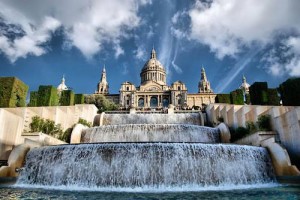 If you’re interested in learning more about the region, there are a variety of museums with exhibitions great for those whose knowledge of Catalonia is a little rusty.
If you’re interested in learning more about the region, there are a variety of museums with exhibitions great for those whose knowledge of Catalonia is a little rusty.
The Museu Nacional d’Art de Catalunya has the most extensive collection of Catalan art in the city, while the Museu D’Història De Catalunya is your one stop shop for everything you need to know about the history of the region.
The Maritime Museum is great for those interested in Catalonia as a naval force, and the Centre de Cultura Contemporània de Barcelona has many great collections and also holds talks about contemporary culture in the city.
If you’re in Barcelona in May, don’t forget to check out the city’s Night at the Museum where museums will open their doors from 19:00 to 01:00, and offer a wealth of one off talks, tours, and performances, for one night only!
Catalan cuisine
As well as Spain’s delicious traditional dishes like paella, tapas, and even churros, the region of Catalonia also offers visitors its own style of finger licking good gastronomy.
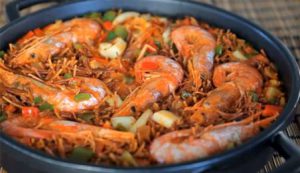 Much of the Catalan cuisine is meat based, like butifarra, a raw pork sausage made with spices, escudella, a meat and vegetable stew, Xai Rostit Amb 12 Cabeçes d’All, a roasted lamb and garlic dish, and embutido, a traditional cured sausage.
Much of the Catalan cuisine is meat based, like butifarra, a raw pork sausage made with spices, escudella, a meat and vegetable stew, Xai Rostit Amb 12 Cabeçes d’All, a roasted lamb and garlic dish, and embutido, a traditional cured sausage.
Fish dishes include Esqueixada, a salad of shredded salt cod, tomatoes, onions, olive oil and vinegar, Suguet de Peix, a fish stew with potatoes, garlic and tomato, and fideua, Catalan’s take on the traditional paella made with tiny noodles instead of rice. This is often available in paella restaurants around the city.
For vegetarians, pa amb tomaquet is a great appetizer, breakfast, or snack. Simply fresh bread with tomato and olive oil, this dish is very light and often hailed as the region’s most famous plate.
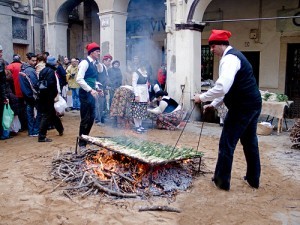 Calçots are also famous in Catalonia, this seasonal dish of barbecued spring onions dipped in a tomato salsa normally eaten at a Calçotada (traditional Catalan BBQ) during the springtime.
Calçots are also famous in Catalonia, this seasonal dish of barbecued spring onions dipped in a tomato salsa normally eaten at a Calçotada (traditional Catalan BBQ) during the springtime.
Escalivada is another famous vegetarian dish made of grilled vegetables like aubergine, pepper, onions, and tomatoes, that have been skinned and chopped up, and then served with oil.
Traditional Catalan sauces include romesco, an almond, roasted garlic, and dried red pepper sauce, and of course aioli, the garlic mayonnaise loved up and down the country.
Dessert wise, the region is known for its crema catalana, a take on the French brulee that is instead cooked in a pan. Mel I Mato is also favoured by the locals, a soft goats cheese with honey and walnuts that’ll bring a new meaning to cheese for pudding.
The Catalan Language
Although Spanish, or Castellano, is largely spoken in Barcelona, Catalan is the national language of Catalonia. Children are often taught in Catalan at school, and many of the street signs are written in this language. It is a mixture of Spanish and French, and like Castellano, is a Romance language.
The History of Catalonia
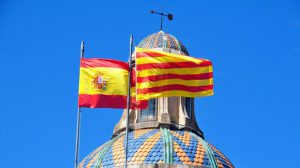 The first use of the name ‘Catalonia’ was in the 12th century, and after the fall of Charlemagne in this era, Catalonia united with the neighbouring Kingdom of Aragon. It was still part of the Kingdom of Aragon when Spain became unified following the marriage of Isabella and Ferdinand, but it operated as a separate region with its own language and laws.
The first use of the name ‘Catalonia’ was in the 12th century, and after the fall of Charlemagne in this era, Catalonia united with the neighbouring Kingdom of Aragon. It was still part of the Kingdom of Aragon when Spain became unified following the marriage of Isabella and Ferdinand, but it operated as a separate region with its own language and laws.
However, when Catalonia chose to support the Habsburgs instead of the Spanish in the War of Spanish Succession, King Philip V banned the Catalan language and culture upon his victory. Such was seen as justified punishment for choosing not to support him in the war.
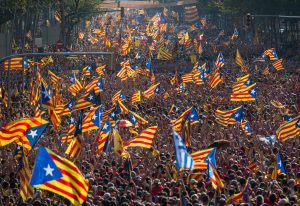 In the 19th century, nationalist sentiment grew in Catalonia and more than a decade later Catalonia was finally recognised as semi- autonomous. This however was short lived. During the Spanish civil war in 1936, the region supported the loosing Republican side. After Franco’s victory, the same suppression of Catalonia took place.
In the 19th century, nationalist sentiment grew in Catalonia and more than a decade later Catalonia was finally recognised as semi- autonomous. This however was short lived. During the Spanish civil war in 1936, the region supported the loosing Republican side. After Franco’s victory, the same suppression of Catalonia took place.
Following the defeats of Hitler and Mussolini, Franco lessened the suppression of Catalonia in fear that he would lose his power in an uprising. After his death in the 1970’s, the country transitioned to a democracy allowing freedom of cultural expression. Since then, the people of Catalonia have been trying to strengthen the Catalan culture and language once again.
Celebrations in Catalonia
Sant Jordi
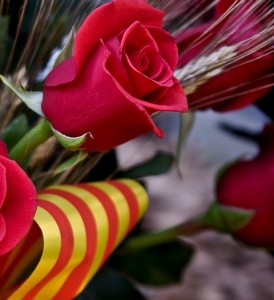 Each year on the 23rd of April, Catalonia celebrates Sant Jordi, the patron saint of Catalonia. As well as La Noche de Sant Joan in June, Sant Jordi is one of the biggest days of the year in Barcelona.
Each year on the 23rd of April, Catalonia celebrates Sant Jordi, the patron saint of Catalonia. As well as La Noche de Sant Joan in June, Sant Jordi is one of the biggest days of the year in Barcelona.
Many compare Sant Jordi to valentine’s day, but the celebration in fact originated from a legend in the 15th century that states Saint George (Sant Jordi) slayed the dragon that was about to eat the King’s daughter. Upon the dragon’s death, a drop of blood hit the floor and from this drop, a rosebush grew. St. Jordi plucked a rose from the bush and handed it to the beautiful princess.
On Sant Jordi, it is typical for lovers to exchange roses and books, as the streets of Barcelona are decorated with rose sellers and book stalls, as well as the national flag of Catalonia and its two colours, red and yellow. It is considered one of the most beautiful days in the Catalan calendar.
The National Day of Catalonia
The National Day of Catalonia commemorates the Spanish War of Succession in 1714. It is held each year on the 11th September and usually attracts large crowds and protests of those wanting Catalan independence from the rest of Spain. It is also a day in which Catalan traditions are celebrated across the region.
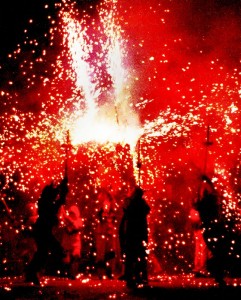 Sant Joan
Sant Joan
The 24th of June sees the sun reach its highest point of the year, marking the official start of summer. In Catalonia, Sant Joan is celebrated with the biggest party of the year.
The night is filled with fireworks and celebrations, street parties continuing until sunrise on the beaches of Barcelona. It is considered one of Barcelona’s most magical nights.
Dia de San Esteban
This special day is celebrated in Catalonia the day after Christmas by eating traditional dishes from the region and leftovers from Christmas dinner, in homage to San Esteban, another important Christian saint.

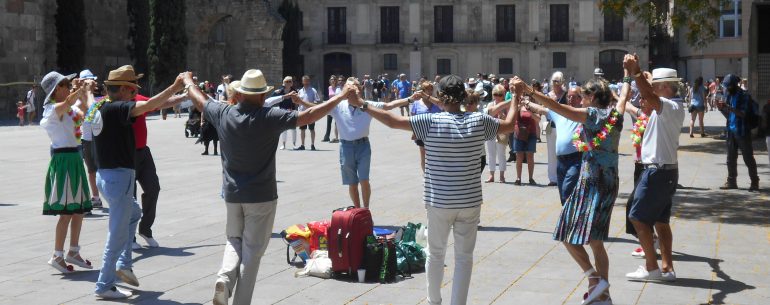
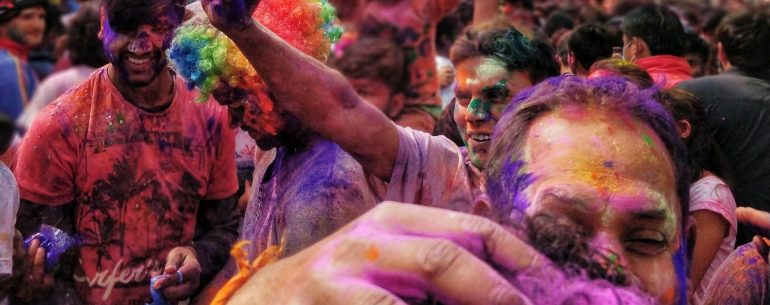

Leave a Reply